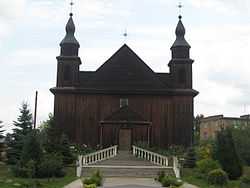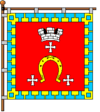Kovel
| Kovel Ковель | |||
|---|---|---|---|
| City | |||
 | |||
| |||
 | |||
| Coordinates: 51°13′0″N 24°43′0″E / 51.21667°N 24.71667°ECoordinates: 51°13′0″N 24°43′0″E / 51.21667°N 24.71667°E | |||
| Country |
| ||
| Oblast |
| ||
| Raion | Kovel City Municipality | ||
| Founded | 13th century | ||
| Magdeburg law | 1518 | ||
| Government | |||
| • Mayor | Oleh Kinder[1] | ||
| Area | |||
| • Total | 47.3 km2 (18.3 sq mi) | ||
| Population (2009) | |||
| • Total | 65,777 | ||
| • Density | 1,400/km2 (4,000/sq mi) | ||
| Time zone | EET (UTC+2) | ||
| • Summer (DST) | EEST (UTC+3) | ||
| Postal code | 45000 | ||
| Area code(s) | +380 3352 | ||
| Website | Municipal official site in Ukrainian | ||
Kovel (Ukrainian: Ковель; Russian: Ковель, translit. Kovel’, Polish: Kowel, Hebrew: קובל) is a city located in the Volyn Oblast (province), in northwestern Ukraine. Serving as the administrative center of the Kovelskyi Raion (district), the city itself is also designated as a separate raion within the oblast. The current estimated population (as of 2013) is around 68,971.[2]Kovel gives its name to one of the oldest Runic inscriptions which were lost during World War II. The Kovel spearhead, unearthed near the town in 1858, contained text in Gothic language (illustration).
History

Kovel (Kowel) was first mentioned in 1310.[3] It received city rights from the Polish king Zygmunt Stary in 1518.[3] In 1547 the owner of Kowel became Bona Sforza, Polish queen.[3] In 1564 starost of Kowel became Kurbski (d. 1584).[3]
After the Partitions of Poland the town fell into the Russian Empire for over a hundred years. During the First World War, the city was a site of the Battle of Kovel between the Central Powers and the Russian Empire. In the interwar period, Kovel served as the capital of Kovel County in Volhynian Voivodeship of the Polish Republic. It was an important garrison of the Polish Army, here the headquarters of the 27th Volhynian Infantry Division was located. Furthermore, at the village of Czerkasy, a large depot of the Polish Army was located. In 1924, construction of the St. Stanislaus Bishop and Martyr Roman Catholic church began.
In World War II, following the Nazi German invasion of Poland and subsequently, their Operation Barbarossa the Germans murdered 18,000 Jews in Kovel, mostly during August and September 1942. Later on, in March and April 1944, Kovel was a site of fierce fighting between the 5th SS Panzer Division Wiking and the Red Army.
During the Volhynian Genocide, the town was a shelter for ethnic Poles, escaping the genocide. In that period, Ukrainian nationalists murdered app. 3,700 Polish inhabitants of Kovel county. In early spring of 1944, the 27th Infantry Division of the Home Army operated in the area. Kovel was captured by the Red Army in July 1944. In 1945, at the insistence of Joseph Stalin (following the Tehran Conference of 1943) Poland's borders were redrawn, the Polish population was forcibly resettled and Kovel was incorporated into the Ukrainian Soviet Socialist Republic. It has been a part of sovereign Ukraine since 1991.
Transportation
Kovel is the north-western hub of the Ukrainian rail system, with six rail lines radiating outward from the city. The first of these was built in 1873, connecting the city with Brest-Litovsk and Rivne. In 1877 Kovel was first linked by rail with Lublin and Warsaw in Congress Poland.
Notable people
- Lesya Ukrainka (1871–1913), Ukrainian poet
- Abraham Zapruder (1905–1970), manufacturer of women’s clothing who filmed the assassination of John Kennedy
- Meir Auerbach (1815–1877), first Ashkenazi Chief Rabbi of Jerusalem.
- Israel Friedlander, rabbi, educator and biblical scholar
- actor Kazimierz Dejmek,
- scholar Andrzej Dembicz,
- physicist Ryszard Horodecki,
- actor Krzysztof Kursa,
- film director and producer Michal Waszynski,
- scientist Janusz Zawisza,
- painter Jolanta Zdrzalik.
Sister cities
Kovel is twinned with
References
- ↑ "Municipal official site in Ukrainian".
- ↑ "Верховна Рада України" [Supreme Council of Ukraine].(Ukrainian)
- ↑ 3.0 3.1 3.2 3.3 Rąkowski, Grzegorz (2005). Wołyń. Pruszków: Oficyna Wydawnicza "Rewasz". p. 85. ISBN 83-89188-32-5.
External links
| Wikimedia Commons has media related to Kovel. |
- Short history of Kowel (English)
- Carrier "Kowel" leased by Poland during World War II
- Tineke Looijenga, Texts & contexts of the oldest Runic inscriptions Published by BRILL. Page 127
- A Testament of a Jewish Woman from Kowel, Poland Source: Safira Rapoport (Ed.), Yesterdays and then Tomorrows, Yad Vashem 2002, p. 183 (in the Hebrew edition).
- David Pentland, "Fight for Kowel, Poland, March/April 1944", Gerhard Fischer Knights Cross signature series
- Historic images of Kovel
- Soviet topographic map 1:100 000
- Photos of Kovel at "Ukraine Photos"
- http://www.shtetlinks.jewishgen.org/kovel/kovel.htm
- http://www.israeli-kovel-org.org/english.html
| |||||||||||||||||||||||

